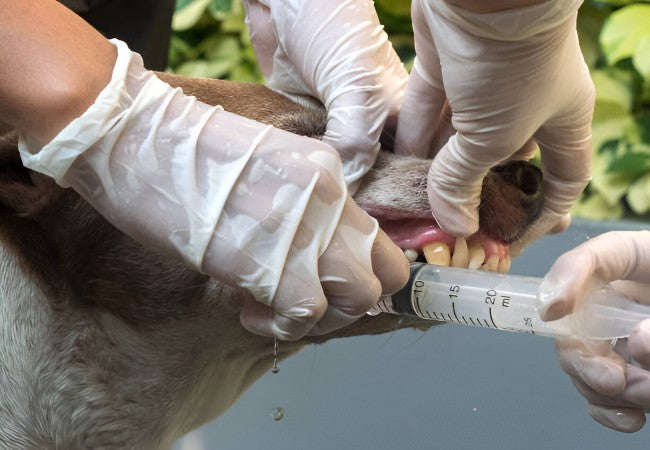Oral Ulceration & CUPS in Dogs – Vet Led Guide 2025 🐶🔥

In this article
🩺 Oral Ulceration & CUPS in Dogs – Vet‑Led Guide 2025 🐶🔥
By Dr. Duncan Houston BVSc
Hello, I’m Dr Duncan Houston, BVSc, founder of Ask A Vet. Chronic mouth sores and ulcers are not just dental issues—they can cause severe pain, loss of appetite, and lower quality of life. In this definitive guide, we examine acute oral ulcers and Chronic Ulcerative Paradental Stomatitis (CUPS)—their underlying causes, signs, diagnosis, treatment, prevention, and compassionate home care strategies. Let’s help your pup find relief and comfort! 🐾
📘 What Is Oral Ulceration?
An oral ulcer is an erosion or break in the mouth’s soft tissues (gums, cheeks, tongue) that exposes deeper layers, often painful and sometimes accompanied by a yellow fibrinous base. These ulcers can be localized or part of broader conditions like stomatitis or cancers. Common triggers include:
- Trauma (sharp toys, burns, electrical cords)
- Systemic illness — uremia, diabetes, hypothyroidism
- Infection — bacteria, viruses like distemper, calicivirus
- Immune‑mediated diseases — pemphigus, lupus
- Cancer in the mouth cavity
- Idiopathic conditions like CUPS
🔥 What Is CUPS (Chronic Ulcerative Paradental Stomatitis)?
CUPS is a painful immune‑mediated condition characterized by ulcers on areas of mouth mucosa that continually contact plaque on teeth, especially near the premolars/canines (so‑called "kissing lesions"). Affected dogs react abnormally to their dental plaque, leading to chronic inflammation and ulceration.
At‑risk breeds: Maltese, Cavalier King Charles Spaniels, Cocker Spaniels, Bouvier des Flandres, Greyhounds, Labradors.
🚩 Clinical Signs & Symptoms
Ulcers and CUPS negatively impact a dog's well‑being. Watch for:
- Halitosis, drooling, blood‑tinged saliva
- Difficulty eating, pawing at mouth, weight loss
- Visible, ulcerated, red, raised lesions ("kissing") on buccal mucosa
- Painful mouth opening, reluctance to play with toys
- Ptyalism (thick salivation), chin/chest skin irritation
- Enlarged lymph nodes, secondary periodontal disease
🔬 Diagnosis & Evaluation
- Oral exam under sedation: Check ulcers, measure pocket depths
- Full‑mouth dental X‑rays or CT: Assess periodontal health, bone involvement
- Biopsy/histopathology: Rule out cancer or autoimmune disease
- Bloodwork & urinalysis: Identify systemic causes (renal, endocrine)
💊 Treatment Strategies
1. Acute Oral Ulcers
- Remove cause: trim foreign body, extract damaged tooth, treat burns 🔧
- Topical therapy: chlorhexidine rinses or protective gels
- Systemic therapy: analgesics, antibiotics, gastroprotectants as needed
2. Chronic Ulcerative Stomatitis (CUPS)
- Full dental cleaning: Remove plaque & calculus; polish; irrigate with chlorhexidine
- Daily home hygiene: Brushing + chlorhexidine rinse; plaque‑inhibitor sealant (OraVet) weekly
- Medication: Pulse antibiotics (clindamycin, metronidazole), anti‑inflammatories (prednisone) as needed
- When home care fails: Targeted extractions (often premolars/molars) to lessen contact ulceration
- Immunomodulation: In severe cases, immune‑therapy may be required under vet supervision
More than 90% of dogs show remission after extractions & plaque control.
🏥 Prognosis & Outlook
- Acute ulcers heal well with prompt treatment.
- CUPS requires ongoing dental care—mostly manageable, rarely heals without intervention.
- Combining dental hygiene, medication, and/or selective extractions often leads to long-term remission.
- Without therapy, CUPS leads to chronic pain, poor appetite, and progression to severe periodontal disease.
🏡 At‑Home Care & Quality‑of‑Life Tools
- Brush twice daily with vet-approved toothpaste.
- Use plaque-control rinses or gels after meals.
- Monitor eating, weight, and drooling daily.
- Assess mouth‑opening and comfort in play.
- Soft chew toys to avoid trauma.
- Nutrition: wet/softened kibble to ease chewing.
🐾 Tools from Ask A Vet
Need real-time hygiene advice? Ask A Vet is available 24/7 to guide brushing, rinsing, extraction care, or complications. 💖
✨ Key Takeaways
- Oral ulcers can stem from trauma, illness, autoimmunity, or idiopathic causes.
- CUPS is an immune-mediated reaction to plaque—chronic, painful, but often treatable.
- Diagnosis requires sedation, dental diagnostics, biopsy, and systemic evaluation.
- Treatment includes cleaning, home care, medication, and selective extractions.
- Home monitoring and comfort tools keep healing on track.
- With proper care, most dogs achieve remission and enjoy a good quality of life. Regular veterinary follow-ups are essential.
If your dog shows signs of mouth pain, drooling, ulcers, or weight loss—don’t wait. Connect with your veterinarian or Ask A Vet today for help and peace of mind.






